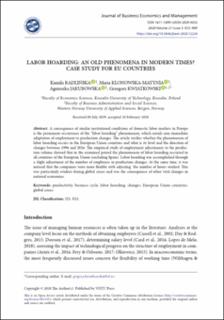| dc.contributor.author | Radlińska, Kamila | |
| dc.contributor.author | Klonowska-Matynia, Maria | |
| dc.contributor.author | Jakubowska, Agnieszka | |
| dc.contributor.author | Kwiatkowski, Gregory | |
| dc.coverage.spatial | Europe | en_US |
| dc.date.accessioned | 2020-12-08T13:31:24Z | |
| dc.date.available | 2020-12-08T13:31:24Z | |
| dc.date.created | 2020-09-10T23:46:31Z | |
| dc.date.issued | 2020 | |
| dc.identifier.citation | Radlińska, K., Klonowska-Matynia, M., Jakubowska, A., & Kwiatkowski, G. (2020). Labor hoarding: An old phenomena in modern times? Case study for EU countries. Journal of Business Economics and Management, 21(3), 872–889. | en_US |
| dc.identifier.issn | 1611-1699 | |
| dc.identifier.uri | https://hdl.handle.net/11250/2712433 | |
| dc.description.abstract | A consequence of similar institutional conditions of domestic labor markets in Europe is the permanent occurrence of the “labor hoarding” phenomenon, which entails non-immediate adaptation of employment to production changes. The article verifies whether the phenomenon of labor hoarding occurs in the European Union countries and what is its level and the direction of changes between 1996 and 2016. The empirical study of employment adjustments to the production volume showed that in the examined period the phenomenon of labor hoarding occurred in all countries of the European Union (excluding Spain). Labor hoarding was accomplished through a slight adjustment of the number of employees to production changes. At the same time, it was noticed that the companies were more flexible with adjusting the number of hours worked. This was particularly evident during global crises and was the consequence of other vital changes in national economies. | en_US |
| dc.language.iso | eng | en_US |
| dc.publisher | Vilnius Gediminas Technical University | en_US |
| dc.rights | Navngivelse 4.0 Internasjonal | * |
| dc.rights.uri | http://creativecommons.org/licenses/by/4.0/deed.no | * |
| dc.subject | productivity | en_US |
| dc.subject | business cycle | en_US |
| dc.subject | labor hoarding | en_US |
| dc.subject | changes | en_US |
| dc.subject | European Union countries | en_US |
| dc.subject | global crises | en_US |
| dc.title | Labor hoarding: An old phenomena in modern times? Case study for EU countries | en_US |
| dc.type | Peer reviewed | en_US |
| dc.type | Journal article | en_US |
| dc.description.version | publishedVersion | en_US |
| dc.rights.holder | Copyright © 2020 The Author(s) | en_US |
| dc.subject.nsi | VDP::Samfunnsvitenskap: 200::Økonomi: 210::Samfunnsøkonomi: 212 | en_US |
| dc.source.pagenumber | 872-889 | en_US |
| dc.source.volume | 21 | en_US |
| dc.source.journal | Journal of Business Economics and Management | en_US |
| dc.source.issue | 3 | en_US |
| dc.identifier.doi | 10.3846/jbem.2020.12228 | |
| dc.identifier.cristin | 1828910 | |
| cristin.ispublished | true | |
| cristin.fulltext | original | |
| cristin.qualitycode | 1 | |

